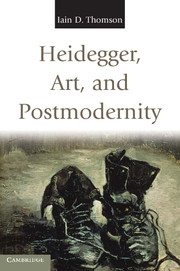Book contents
- Frontmatter
- Contents
- List of Illustrations
- Acknowledgments
- Abbreviations Used for Works by Heidegger
- A Note on the Notes (Redux)
- Introduction
- 1 Understanding Ontotheology, or “The History that We Are”
- 2 Heidegger's Critique of Modern Aesthetics
- 3 Heidegger's Postmodern Understanding of Art
- 4 “Even Better than the Real Thing”?
- 5 Deconstructing the Hero
- 6 The Philosophical Fugue
- 7 The Danger and the Promise of Heidegger, an American Perspective
- 8 Against Conclusions
- References
- Index
Introduction
Heidegger, Art, and Postmodernity
Published online by Cambridge University Press: 05 June 2012
- Frontmatter
- Contents
- List of Illustrations
- Acknowledgments
- Abbreviations Used for Works by Heidegger
- A Note on the Notes (Redux)
- Introduction
- 1 Understanding Ontotheology, or “The History that We Are”
- 2 Heidegger's Critique of Modern Aesthetics
- 3 Heidegger's Postmodern Understanding of Art
- 4 “Even Better than the Real Thing”?
- 5 Deconstructing the Hero
- 6 The Philosophical Fugue
- 7 The Danger and the Promise of Heidegger, an American Perspective
- 8 Against Conclusions
- References
- Index
Summary
Martin Heidegger (1889–1976) was probably the most influential philosopher of the twentieth century; certainly he remains the most controversial. This enduring controversy stems not only from Heidegger's undeniably horrendous politics, legendarily difficult prose, and profoundly challenging views, but also from the fact that a list of the major thinkers inspired by the works he wrote after Being and Time (1927) reads like the required table of contents for any good anthology of “contemporary continental philosophy”: Giorgio Agamben, Alain Badiou, Jean Baudrillard, Maurice Blanchot, Stanley Cavell, Gilles Deleuze, Jacques Derrida, Hubert Dreyfus, Michel Foucault, Luce Irigaray, Jacques Lacan, Emmanuel Levinas, Jean-François Lyotard, Herbert Marcuse, Jacques Rancière, Richard Rorty, Charles Taylor, Gianni Vattimo, and Slavoj Žižek. For all these “postmodernists” (the heading under which this diverse group is often lumped together), Heidegger's later philosophy served as a formative influence as well as a primary point of departure. Yet, despite his immense influence, Heidegger's own philosophical attempt to articulate a postmodern understanding of being – and so help usher in a postmodern age – remains shrouded in darkness and confusion along with the other views at the heart of his later thought. That is a situation this book hopes to help remedy.
- Type
- Chapter
- Information
- Heidegger, Art, and Postmodernity , pp. 1 - 6Publisher: Cambridge University PressPrint publication year: 2011



